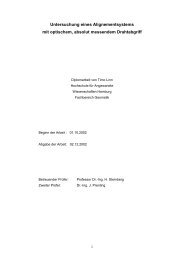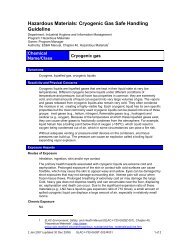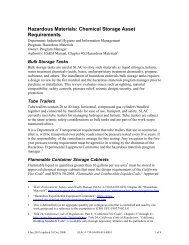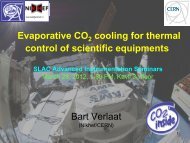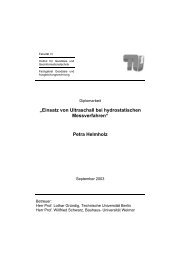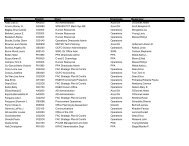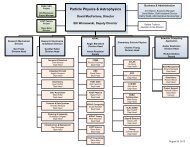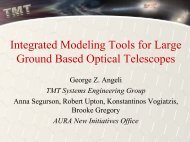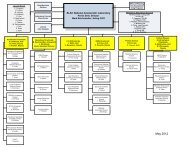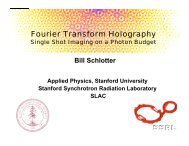BES - SLAC Group/Department Public Websites - Stanford University
BES - SLAC Group/Department Public Websites - Stanford University
BES - SLAC Group/Department Public Websites - Stanford University
Create successful ePaper yourself
Turn your PDF publications into a flip-book with our unique Google optimized e-Paper software.
FYO7 <strong>SLAC</strong> S CIENCE AND T ECHNOLOGY S ELF E VALUATION<br />
Objective 1.2 Leadership in Science and Technology<br />
For work leading to the recently-released Reference Design Report (RDR), <strong>SLAC</strong> physicists were<br />
Area Leaders for every section of the machine except the damping ring, including both electron and<br />
positron sources, the bunch compressors, the main linacs and the beam delivery system. <strong>SLAC</strong><br />
contributions to the damping ring design include the lead on electron cloud suppression and studies<br />
of the fast ion instability. <strong>SLAC</strong> physicists are Technical or Global System Leaders for four areas.<br />
Eight members of the Global Design Effort (GDE) are from <strong>SLAC</strong> including the Lead Accelerator<br />
Physicist for the Americas Region, the Electronic Document Management System (EDMS)<br />
Committee Chair, the Systems Integration Engineer and the Lead Editor for the RDR.<br />
An extensive ILC R&D program includes the beam delivery system (BDS), electron and positron<br />
sources, RF power sources and high availability hardware systems<br />
Engineering Design Phase<br />
The ILC effort has entered an Engineering Design Phase to refine the design and cost estimate over 3<br />
years, to culminate in a detailed Engineering Design Report (EDR) in 2010. <strong>SLAC</strong> has chosen to<br />
focus engineering work on four main areas—the electron source, the beam delivery system, the main<br />
linac overall systems design and the RF power sources—and will lead these areas through the EDR<br />
and into construction. <strong>SLAC</strong> also has primary responsibility for systems integration and for<br />
developing an installation model. For the damping rings, <strong>SLAC</strong> will continue a major effort on the<br />
vacuum system design, in particular on electron cloud, fast-ion and collective effects. This work is in<br />
collaboration with LBNL and Cockcroft Institute. <strong>SLAC</strong> continues to play a supporting role in the<br />
positron source and bunch compressors.<br />
The <strong>SLAC</strong> accelerator complex provides facilities to support a wide range of ILC R&D. These are<br />
discussed in other sections of this report.<br />
Reviews, Meetings and <strong>Public</strong>ations<br />
The ILC group participates actively in the national and international community through reviews and<br />
meetings. The <strong>SLAC</strong> ILC group played a major role in formulating the shape and content of the three<br />
ILC GDE Meetings in November 2006, February 2007 and May 2007. <strong>SLAC</strong> ILC <strong>Department</strong><br />
members made significant contributions to leadership of area, technical and global groups and as<br />
working group conveners.<br />
<strong>SLAC</strong> ILC members presented papers at the 17th International Spin Physics Symposium (SPIN06),<br />
the IEEE Nuclear and Sciences Symposium, and the Workshop on Polarized Sources and Targets, the<br />
Asian Particle Accelerator Conference (APAC07), the International Workshop on Electron-Cloud<br />
Effects (ECLOUD07), and the Computational High Energy Physics conference (CHEP-07). <strong>SLAC</strong><br />
had a major presence at the Particle Accelerator Conference (PAC 07) with five invited papers, four<br />
contributed talks and more than 39 papers.<br />
<strong>SLAC</strong> hosted the US High Gradient Research Workshop (HG 2007) and a Workshop on IR<br />
Engineering (IRENG07).<br />
<strong>SLAC</strong> ILC physicists participated in the RDR cost reviews. They also made presentations at the ILC<br />
Machine Advisory Committee (MAC) meetings.<br />
<strong>SLAC</strong> ILC members participated in many advisory and review committees including HEPAP, P5,<br />
MUTAC, the DPB Executive Committee, the NSF and DOE Committees of Visitors, the LCLS<br />
Facilities Advisory Committee, the CLIC and FNAL Accelerator Advisory Committees, the FNAL<br />
Steering <strong>Group</strong>, the <strong>SLAC</strong> director and associate director search committees, the advisory board for<br />
the <strong>SLAC</strong>/FNAL joint SciDAC project (COMPASS), and numerous conference scientific and<br />
program committees.<br />
Collaborations<br />
The ILC <strong>Department</strong> has a long history of collaboration with KEK and, within the US, with ANL,<br />
F I N A L P A G E 3 9



